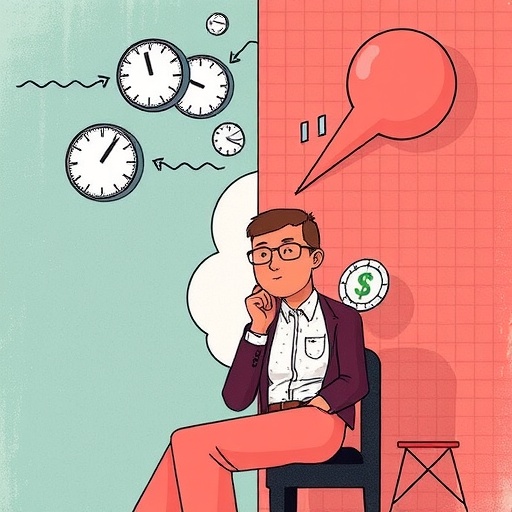In an era where decision-making is increasingly recognized as a complex interplay between cognition and emotion, the work of Heerema and Pessiglione throws a transformative spotlight on the profound ways in which our mood-related physiological states shape economic choices. Their corrected study, published in Communications Psychology, advances our understanding of the subtle yet pervasive influences that mood exerts beyond conscious awareness, revealing crucial mechanisms by which the body and mind converge to bias decisions of significant consequence.
At the core of this research lies an inquiry into how internal physiological fluctuations—those often unnoticed changes in heart rate variability, hormonal secretions, and autonomic nervous system activity—modulate the valuation processes that govern economic behavior. Traditionally, economic models posited agents as rational actors, weighing options with detached logic. However, this emerging evidence dismantles that myth, illustrating that even transient affective states leave persistent footprints on neural computations of value and risk.
Heerema and Pessiglione’s correction to their earlier work refines the precision of these findings, ensuring that the nuanced relationship between physiological mood markers and decision outcomes rests on robust empirical grounding. Through rigorous experimentation, involving the integration of psychophysiological measurements with well-validated economic choice paradigms, their study elucidates how mood states embodied in cardiac and neural rhythms bias choices in predictable directions.
One of the pivotal revelations underscores that elevated sympathetic arousal, often correlated with heightened stress or anxiety, systematically inclines individuals toward risk-averse decisions. Conversely, parasympathetic dominance, which reflects calmer mood states, predisposes decision-makers to embrace greater financial risks. This polarity highlights a biological underpinning for seemingly irrational swings in market behavior and personal financial management, shedding light on persistent puzzles in behavioral economics.
The methodology emphasized precision tracking of autonomic indicators paired with functional neuroimaging to unpack how mood-related physiological states interface with brain regions pivotal to economic valuation, notably the ventromedial prefrontal cortex and the striatum. This multisystem approach reveals a feedback loop whereby physiological mood states inform neural valuation networks, which in turn shape preference formation and choice execution in real time.
Importantly, the researchers delineate the temporal dynamics of these effects, showing that mood-induced physiological states do not merely exert acute, transient influences but also shape longer-term decision trends. This insight challenges the reductionist perspective that mood effects are fleeting, instead positing that physiological mood signatures integrate over time to sculpt economic behavior in stable ways.
The implications of these findings extend beyond individual choice, offering explanatory power for collective economic phenomena such as market bubbles and crashes. If mood-linked physiological states can bias economic decisions at the individual level, their aggregate impact might underpin cyclical volatility observed in financial markets, embedding human affective physiology within macroeconomic dynamics.
Moreover, the study’s correction also addresses potential confounds inherent in measuring physiological states during complex decision tasks, enhancing the reliability and validity of inferences drawn. By refining the statistical models and controlling for extraneous variables, the authors fortify the causal argument linking mood-related bodily states to economic decision biases.
Heerema and Pessiglione’s findings invite a reexamination of economic theory, suggesting that integration of affective neuroscience and psychophysiology is indispensable for a holistic science of choice. Going forward, models that incorporate dynamic mood-physiology interactions promise to yield predictive frameworks with richer explanatory and applicative scope, including personalized financial advising and behavioral interventions.
Furthermore, this research opens exciting vistas for interdisciplinary collaboration, as insights into mood-dependent valuation can inform artificial intelligence systems designed to emulate or support human decision-making, as well as clinical approaches addressing mood disorders that disrupt economic functionality.
In practical terms, the data raise critical awareness of the subtle vulnerabilities in decision-making processes, highlighting the necessity for individuals and institutions to consider mood management as part of strategy and policy formulation. Training in emotional regulation or biofeedback techniques could mitigate the biasing effects of adverse physiological states, ultimately fostering more rational economic behaviors.
The correction also enriches the transparency and reproducibility of psychophysiological research in economics, setting standards for future investigations that seek to unravel the body-mind nexus underlying complex human behaviors. Such rigor is essential to build reliable bridges across the traditionally disparate disciplines of economics, psychology, and biology.
As scientific communities continue to untangle the threads connecting mood, physiology, and choice, the work of Heerema and Pessiglione stands as a milestone, affirming that economic decisions cannot be disentangled from the living, physiological substrate of human experience. Their study invites scholars and practitioners alike to embrace a more embodied vision of human rationality—one that acknowledges the silent, rhythmic conversations between heart and brain that determine how we value the world and act within it.
This paradigm shift prompts compelling questions for ongoing research: How might individual differences in physiological reactivity modulate decision biases? Can interventions targeting mood physiology be calibrated to nudge economic behavior toward socially optimal outcomes? What relations exist between chronic mood disorders and economic vulnerability? As these queries unfold, the enriched framework offered by Heerema and Pessiglione expands the horizon of economic psychology into a profoundly integrative domain.
By illuminating the physiological architecture beneath mood-anchored economic choices, this work challenges prevailing assumptions and charts new courses for both theoretical innovation and applied science. As we endeavor to build systems, technologies, and policies responsive to the nuanced reality of human decision-making, acknowledging these embodied influences emerges not merely as an option but as an imperative.
In sum, the author-corrected study published in Communications Psychology delivers a compelling narrative marrying physiology, mood, and economic cognition, offering a vital key to unlocking the mysteries of how our bodies shape the economic realities we navigate. This work is poised to inspire a wave of research and application focused on harnessing the power of mood physiology to enhance decision quality in an increasingly complex world.
Subject of Research: The influence of mood-related physiological states on economic decision-making processes.
Article Title: Author Correction: How mood-related physiological states bias economic decisions.
Article References: Heerema, R., Pessiglione, M. Author Correction: How mood-related physiological states bias economic decisions. Commun Psychol 3, 110 (2025). https://doi.org/10.1038/s44271-025-00290-x
Image Credits: AI Generated




